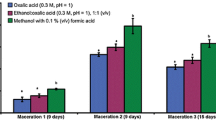Abstract
The ability of grape skins to catalyze in vitro conversion of p-coumaric acid to the more potent antioxidant caffeic acid was studied. Addition of different concentrations of p-coumaric to red grape skins (Cabernet Sauvignon) resulted in formation of caffeic acid. This caffeic acid formation (Y) correlated positively and linearly to p-coumaric acid consumption (X): Y = 0.5 X + 9.5; R 2 = 0.96, P < 0.0001. The kinetics of caffeic acid formation with time in response to initial p-coumaric acid levels and at different grape skin concentrations, indicated that the grape skins harboured an o-hydroxylation activity, proposedly a monophenol- or a flavonoid 3′-monooxygenase activity (EC 1.14.18.1 or EC 1.14.13.21). The K m of this crude o-hydroxylation activity in the red grape skin was 0.5 mM with p-coumaric acid.





Similar content being viewed by others
References
Alvarado IE, Navarro D, Record E, Ashter M, Asther M, Lesage-Meessen L (2003) Fungal biotransformation of p-coumaric acid into caffeic acid by Pycnoporus cinnabarinus: an alternative for producing a strong natural antioxidant. World J Microbiol Biotechnol 19:157–160
Andreasen MF, Landbo AK, Christensen LP, Hansen A, Meyer AS (2001) Antioxidant effects of phenolic rye (Secale cereale L.) extracts, monomeric hydroxycinnamates, and ferulic acid dehydrodimers on human low-density lipoproteins. J Agric Food Chem 49:4090–4096
Arnous A, Meyer AS (2008) Comparison of methods for compositional characterization of grape (Vitis vinifera L.) and apple (Malus domestica) skins. Food Bioprod Process 86:79–86
Barbe C, Dubourdieu D (1998) Characterisation and purification of a cinnamate esterase from Aspergillus niger industrial pectinase preparation. J Sci Food Agric 78:471–478
Bogs J, Ebadi A, McDavid D, Robinson SP (2006) Identification of the flavonoid hydroxylases from grapevine and their regulation during fruit development. Plant Physiol 140:279–291
Chen JY, Wen PF, Kong WF, Pan QH, Wan SB, Huang WD (2006) Changes and subcellular localizations of the enzymes involved in phenylpropanoid metabolism during grape berry development. J Plant Physiol 163:115–127
Cheynier V, Moutounet M (1992) Oxidative reactions of caffeic acid in model systems containing polyphenol oxidase. J Agric Food Chem 40:2038–2044
Duke SO, Vaughn KC (1982) Lack of involvement of polyphenol oxidase in o-hydroxylation of phenolic compounds in mung bean seedlings. Physiol Plant 54:381–385
FAO-UN (2009) FAOSTAT database on agriculture. FAOSTAT-FAO statistical database. 2-6-2009. Food and Agriculture Organization of the United Nations
Harel E, Mayer AM (1971) Partial purification and properties of catechol oxidases in grapes. Phytochemistry 10:17–22
Herrmann K (1989) Occurrence and content of hydroxycinnamic and hydroxybenzoic acid compounds in foods. Crit Rev Food Sci Nutr 28:315–347
Janovitzklapp A, Richard F, Nicolas J (1989) Polyphenoloxidase from apple, partial purification and some properties. Phytochemistry 28:2903–2907
Kojima M, Takeuchi W (1989) Detection and characterization of p-coumaric acid hydroxylase in mung bean, Vigna mungo, seedlings. J Biochem 105:265–270
Landbo AK, Meyer AS (2001) Enzyme-assisted extraction of antioxidative phenols from black current juice press residues (Ribes nigrum). J Agric Food Chem 49:3169–3177
Landbo AK, Kaack K, Meyer AS (2007) Statistically designed two step response surface optimization of enzymatic prepress treatment to increase juice yield and lower turbidity of elderberry juice. Innov Food Sci Emerg Technol 8:135–142
Larson RL, Robles RP (1981) p-Coumaric acid hydroxylation by a Zea Mays L. phenolase preparation. Maydica 26:199–207
Meyer AS, Donovan JL, Pearson DA, Waterhouse AL, Frankel EN (1998) Fruit hydroxycinnamic acids inhibit human low-density lipoprotein oxidation in vitro. J Agric Food Chem 46:1783–1787
Nakamura K, Amano Y, Kagami M (1983) Purification and some properties of a polyphenol oxidase from Koshu grapes. Am J Enol Vitic 34:122–127
Pan MH, Lai CS, Dushenkov S, Ho CT (2009) Modulation of inflammatory genes by natural dietary bioactive compounds. J Agric Food Chem 57:4467–4477
Pinelo M, Arnous A, Meyer AS (2006) Upgrading of grape skins: significance of plant cell-wall structural components and extraction techniques for phenol release. Trends Food Sci Technol 17:579–590
Rapeanu G, Van Loey A, Smout C, Hendrickx M (2006) Biochemical characterization and process stability of polyphenoloxidase extracted from Victoria grape (Vitis vinifera ssp. Sativa). Food Chem 94:253–261
Revilla I, Gonzalez-SanJose ML (2003) Compositional changes during the storage of red, wines treated with pectolytic enzymes: low molecular-weight phenols and flavan-3-ol derivative levels. Food Chem 80:205–214
Sachan A, Ghosh S, Mitra A (2004) An efficient isocratic separation of hydroxycinnamates and their corresponding benzoates from microbial and plant sources by HPLC. Biotechnol Appl Biochem 40:197–200
Salameh D, Brandam C, Medawar W, Lteif R, Strehaiano P (2008) Highlight on the problems generated by p-coumaric acid analysis in wine fermentations. Food Chem 107:1661–1667
Sato M (1969) Conversion by phenolase of p-coumaric acid to caffeic acid with special reference to role of ascorbic acid. Phytochemistry 8:353–362
Singleton VL, Salgues M, Zaya J, Trousdale E (1985) Caftaric acid disappearance and conversion to products of enzymic oxidation in grape must and wine. Am J Enol Vitic 36:50–56
Strack D (2001) Enzymes involved in hydroxycinnamate metabolism. In: Methods in Enzymology. Academic Press Inc, San Diego, pp 70–81
Vaughan PFT, Butt VS (1969) Hydroxylation of p-coumaric acid by an enzyme from leaves of spinach beet (Beta vulgaris L.). Biochem J 113:109–115
Yokotsuka K, Shimizu T, Shimizu T (1991) Polyphenoloxidase from 6 mature grape varieties and their activities towards various phenols. J Ferment Bioeng 71:156–162
Acknowledgments
The Distell Group Ltd (Stellenbosch, South Africa) is acknowledged for supplementation of the wine grape samples. Donation of the Pectinex BE Colour enzyme preparation from Novozymes A/S is gratefully acknowledged.
Author information
Authors and Affiliations
Corresponding author
Rights and permissions
About this article
Cite this article
Arnous, A., Meyer, A.S. Grape skins (Vitis vinifera L.) catalyze the in vitro enzymatic hydroxylation of p-coumaric acid to caffeic acid. Biotechnol Lett 31, 1953–1960 (2009). https://doi.org/10.1007/s10529-009-0103-5
Received:
Revised:
Accepted:
Published:
Issue Date:
DOI: https://doi.org/10.1007/s10529-009-0103-5




